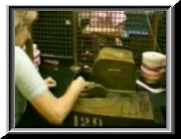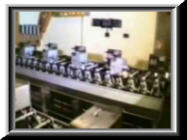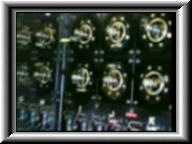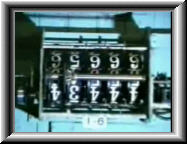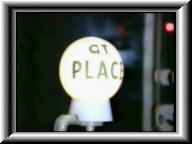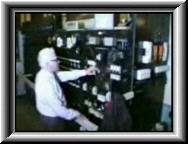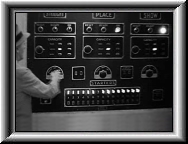This is one of several pages relating to the history of the automatic totalisator, its invention in 1913, the inventor George Julius and the Australian company he founded in 1917 which became a monopoly and later part of an oligopoly in this field. This page relates the history of the company mentioned above, Automatic Totalisators Ltd. This is a history only non commercial page. If you wish to start from the beginning then go to the index .
Copyright © 2003 Email - totehis@hotmail.com
Julius Tote Video Clips
The first seven video clips in this section are extracts from a video made by Andrew Keene. He produced this video as part of a study made by GLIAS of the Harringay greyhound racing track's Julius Totalisator prior to its closure in 1987. GLIAS (The Greater London Industrial Archaeology Society) is a registered charity devoted to recording and explaining London's fast disappearing industrial history. Charles Norrie from GLIAS, organised the acquisition of this video and copyright approval to use it.
I give thanks to the above for their foresight in recording this history. I have been unable to acquire any video footage from the remnants of Automatic Totalisators, the company that produced these systems. Ironically this footage came from the other side of the world.
The system in these clips is not electronic, it is electro mechanical. This technology existed long before the invention of the electronic computer. The Harringay system was installed in 1930. In some cases I have edited the original video to get different views of the same equipment into one clip.
The eighth video is of Hialeah racetrack at Miami and the Julius Totalisator which was installed there in 1932. It shows images of the crowds, a race running, Julius Tote ticket issuing machines, the tote mainframe as well as infield and outfield indicators.
Further to the last video, titled Opening Day Hialeah Park 1932 there is additional information on the Hialeah system in the Automatic Totalisators in America chapter of this website as well as some images with associated text in the Photo Gallery Continued chapter.
Following are 6 video clips which are extractions from the raw footage of an interview conducted by Racing Queensland in the Eagle Farm Racing Museum in 2009 mainly about the Julius Tote that is the centrepiece of this museum. The system in these clips is a static display only however as these are video clips it seems appropriate to present them here.
| Video Clip Number | Video clip description |
Clip 1
Clip 2
Clip 3
Clip 4
Clip 5
Clip 6 | 1 Introduction to George Julius and his totalisators
2 Interview continuation - Describing the Shaft Adders
3 Interview continuation - Describing the Odds Calculators
4 Interview continuation - Describing the Front End system
5 Interview continuation - Describing the Ticket Issuing Machines
6 Interview continuation - Discussing the PDP11 system that replaced the Julius tote |
There is another link in the links page of this website to a British Pathe Website video clip showing what looks like a J5 TIM in operation in Sydney as well as a drum type shaft adder in action. The link can be found here titled The British Pathe Website.
There is another source of video of a working Julius totalisator. The film was shot in 1935.
It is titled New tote for Randwick punters. It is available from the National Film and Sound Archive web site. The title number is 187881.
The production company is Cinesound Productions. You may be able to attain a private copy of this. It is not possible to attain copyright approval to show this video at the present time.
When you visit the National Film and Sound Archive web site hover on the
Collection menu bar option and select Search the collection from the drop down list. Next enter totalisator
spelt with an s not a z in the Search for dialogue box and click on the SEARCH button. Finally click on the title SPORT. NEW TOTE FOR RANDWICK PUNTERS
For some time I have been interested in the sound these systems made.
I have never seen or heard an electro mechanical tote working. As the above video clips of the Harringay system provide some interesting audio tracks of the sound emanating from this electromechanical equipment, I think it appropriate to consider this sound here. Following is
an extract from Tote Topics number 19 July 1968. It describes the sound of an electro
mechanical totalisator as well as comparing it to an early computer totalisator.
Tote Topics was the Automatic Totalisators company magazine.
| Electronic Totalisators II The characteristics of Electronic Totalisators.
|
We have seen that the Electronic Totalisator is entirely different from the electro mechanical
types both as regards its equipment and its characteristics. Let us look at these differences in a little
more detail, because in them we will find the essential features of the Electronic Totalisator, its
place in the entire scene and even the basic reasons for its very existence.
In the machine room of an electro mechanical totalisator there is motion, constant motion, and noise.
With betting in progress, the constant chatter of the escapements blends with the purring of the counters
and the low rumble of the drives to give a quite characteristic sound. This sound, both in intensity
and pitch, indicates to the experienced totalisator operator, even more clearly than his eyes, the
state of the queues outside and the conditions around the selling houses. He scarcely needs a clock, so
accurately is he able to predict from the betting pattern the time to the start of the next race. The
equipment consists of row upon row of shafts and gears and escapement wheels and mechanical counters.
At first sight it seems entirely mechanical as the electrical portions are buried deep
inside.
With the smaller "counter tote" using electromagnetic counters, the pattern changes to that of a telephone
exchange. There is the click of the relays and the clack of the counters as the bets pile up. One is
still left with the impression of a mechanical device with the moving counters and manual operations.
However, the position changes entirely when we go to an Electronic Totalisator. The machine room consists
of one or more rows of silent steel cabinets. Lights blink continually on the front panels of the cabinets
indicating the progress of betting. Every ninety seconds new odds ripple along the boards and with
a staccato burst the high speed printer spews out another page of updated odds and pool figures. Otherwise
all is silent and the lights blink on. The operators move quietly about, occasionally flipping a
switch or pushing a button to stop betting or calculate dividends or complete some similar, but normally
laborious, task in the blink of an eye.
P.J.G.

Neville Mitchell made an audio tape in 2003 about the workings of these electro mechanical systems, for Bob Doran and Bob Moran (yes two Bobs, one Doran one Moran) both intensely interested in the mechanics and restoration of these systems and having an interest in George Julius and his company Automatic Totalisators Ltd. I have included a couple of transcribed extracts from Neville Mitchell's audio tape here, as they can be well visualised in the above video clips. Before I proceed, just a bit of frivolous diversion. How do two people with names that differ by one letter only, both become so interested in a man George Julius and his invention? I have often pondered about this. How about this frivolity! Bob Doran and Bob Moran differ by one letter. One name has D where the other has M providing two letters. Take D and skip two letters in the alphabet towards M and you get G. Take M and skip 2 letters towards G and you get J. Now, G and J put together G.J. ... hmmm ... George Julius! Now G and J are separated by two characters in the alphabet H and I. Now what do we have? Hi George Julius. How could they help but be drawn into this subject together? Neville's transcribed extracts are presented under the following two headings:
| The Mystique of these machines |
The mystique of the machines was something I experienced, particularly in Melbourne, not so much in Sydney. The men who operated the four major tracks there had been with these machines since 1936 and on the decommissioning day, I saw emotions that were quite unbelievable. They were seeing the last day of operations with this sort of gear. The strictness with which the engineers ran these systems was somewhat akin to a military operation, they really had a lot of power. They had a lot of routines set down and to be an apprentice in those days was a lot of sweeping the floors and making the tea for a long long time before you actually got your hands on any piece of equipment. And I believe in the early days in Melbourne, if an apprentice was seen with his hands out of his pockets in the machine room, he would get a swift slap around the ears. The same thing applied in New Zealand. I read some stories from there and I actually knew a couple of the engineers and they applied the same very very strict mode of operation on their set-ups. They were extremely proud of these machines and some of them spent all of their, what you would call, idle time in routine maintenance and polishing of brass and things like that, that made these machines absolute showrooms.
Giant Drum Assembly
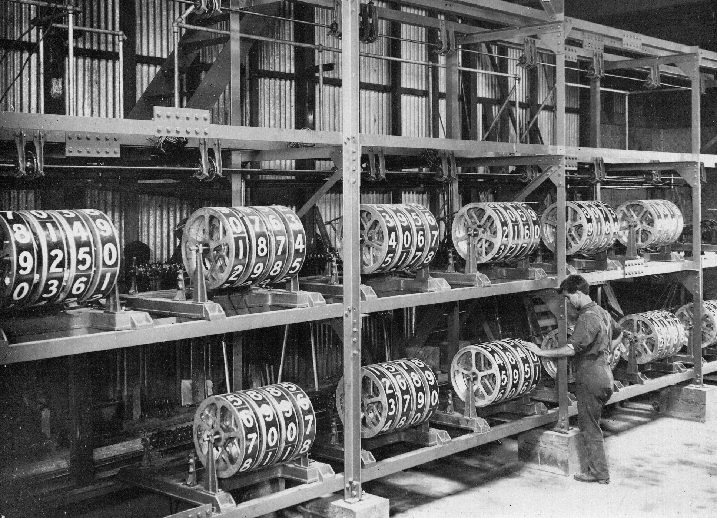
In the display of odds and the like, there was a certain evolution. In the very early days the actual readout of the adder was onto a giant drum, probably 600mm in diameter and the digits 0 to 9 were displayed on them and there would be whatever numbers required to display the amount of tickets that were sold on a particular horse. These were enormous machines and beautifully made and I reinstalled one in Thailand back in 1969 and I was quite amazed at the ingenuity of it and how large it was and some of the techniques; they had switching circuits for the decade counting from one digit to the next which were mercury pots, with probably about a 25mm diameter pot 30mm deep that was filled with mercury lying side by side, and then a fork like a span, which was the switch, would dip into it, and that would create the circuit to the next decade. And you can imagine how absolutely accurate that was, there was no chance of a dirty contact or a miss-up in a norm transfer. However when you got these big systems working rather quickly, the building shook a bit!
After seeing the image above, that I have added to this text transcribed from Neville's tape, Neville sent the following information on 13/1/2010:
Yes, the drum adders pictured in the clip are very similar to the adders I re-installed in Bangkok in October 1969. They were used to indicate tickets sold, an odd way of showing the betting "Odds'.
The building was a box like construction on steel pylons several metres high under the stand in the Public area of the track. When the betting was as full speed as it was most of the time, the erratic stop start action of the drums caused the building to "shake". The drive to the adders was a 10 hp universal electric motor with a simple field current speed controller, which we had set at an optimum shaft speed.
I did have photo's of this installation, but my camera was lost when my tourist bus overturned near the airport, I was unhurt but the camera disappeared in the chaos after the accident.
Neville Mitchell sent me an email on 15 January 2004 which contained the following anecdote:
Did I ever tell you that at Flemington the win place tote could be run with a power shortage. The auxiliary power supply could supply enough power to run the betting circuits, but not enough to run the adder drive motor[s], so a hatch was removed from the floor exposing a wide drive belt, a man would stand on the belt and work it like a treadmill energising the adder input shafts, thus keeping the tote running. Funny how some of the things like the above anecdote come to mind. I was told about this on the day the Flemington tote was taken to the metal recyclers, and I was shown how it worked by Alf Schloeffel [Nick named "snifter" because he always had a runny nose]. Alf went to Melbourne in 1936 for 6 weeks for the installation of Flemington, and was still there in 1975.
In April 2019, after reading Neville's comment above, Peter Nelson added the following comments relating to Alf:
Alf told me whilst in Melbourne his Father passed away. The company flew him home on the plane via Canberra with the Melbourne politicians from Essendon Airport, he returned to Melbourne on the train. After a couple of months Alf asked the boss Mr. Bill Dick if he could go home to Sydney as his Mother needed help with the shop she and Alf's father ran together. The reply from the manager was wait a while until they had finished the install at Pakenham or Mornington race clubs, I believe the team was installing the Mentone system at this time.
He and Bob Davies lived in rooms in Mentone paid for by ATL. Alf a few weeks later asked to go home again, Mr Dick told him there was no work in the factory for him back in Sydney at this time, so he better stay a while longer. So in this time period, Bob and Alf met two Melbourne girls fell in love and eventually married, never returning home to Sydney.
I asked Alf one day, why didn't you just demand to go home, he told me this: In those days Peter, if the boss told you to do something you did as you were Bloody Well Told ...
Alf started his apprenticeship with ATL on the 15th of May 1925 at the old Alice street factory; he and Bob Davies, Alf Pople, Gordon Collier, Fred Berry and Joe Waddington worked after retirement for a number of years to assist with keeping the old system going, until the new J18 terminals running on the new PDP11 system was completed. Alf smoked all his life, Camel and Menthol cigarettes he always carried both, ate a sugar bag of the wrong foods most days, he described his favourite lunch to me as Best Butter and Ham sandwiches with lashings of butter, followed by a nice piece of cake, a large mug of tea with sugar and worked hard all his life. Alf was a fun chap, skinny and he lived in good health for 84 years.
In May 2019 Peter Collier wrote the following corrections:
The note about one manpower backup is not factually correct. There was always enough power for the adders. They did lift the floor and treadmill the belt using it in an emergency if all power had failed, to keep tension on all the adders so that the clutches coupling the escapements would transfer all the bets to the counter so that they could get an accurate read.
It was a rare occurrence as the 120v motor generator set had an automatic failover to a diesel driven generator and if that had failed everything would stop. The diesel generator was always running on a raceday and there was a staff member sitting in the generator room watching the meters to ensure the voltage was in spec just in case it was required.
Also Gordon Collier did not work after retirement.
Alf went to Melbourne in 1936 for 6 weeks for the installation of Flemington to provide support for the Caulfield Cup.
When Neville read Peter's comment about the use of the treadmill, he replied:
I was shown the trapdoor by the two Alfs one Saturday morning and told about its use as a treadmill. It was not demonstrated to me.
The second Alf referred to in Neville's comment is Alf Pople mentioned in Peter Nelson's comments.

To find out more about the Harringay Julius Tote shown in many of the video clips above, read Charles Norrie's excellent article titled The Harringay Greyhound Stadium Totalisator and George Alfred Julius
Acknowledgements
- Thanks to Andrew Keene, Charles Norrie and other members of GLIAS for creating and allowing these video clips to be presented here.
- Thanks to Bob Plemel ex Engineering Manager of Automatic Totalisators Limited for hosting these film clips.
- Thanks to Kevin Martin, for informing me that the Hialeah video presented in this page is in the public domain and for providing me with a copy of it.
- Thanks to Neville Mitchell ex Automatic Totalisators Limited Manager and Engineer for another audio tape, the first is transcribed in Memories of the final factory
- Thanks to Brian Riley a long serving ex Automatic Totalisators Limited Technician for thinking of the idea and persevering with converting and uploading the Julius Tote interview video clips to YouTube.
- Thanks to Peter Nelson, an ex Automatic Totalisators Limited Engineer and Trainer for having provided the additional comments regarding Alf Schloeffel .
- Thanks to Harry Lane, an ex Automatic Totalisators Limited Tote Manager for correcting the spelling of Alf Schloeffel's surname, which had been spelt Schoffel.
- Thanks to Peter Collier, an ex Automatic Totalisators Limited Chief Engineer for his corrections.
- Thanks to my younger son, who is no longer 11 as he was when he initially helped with writing HTML for this site, has since completed an Information Technology degree and has been working in the industry for over a decade.

Comments and suggestions welcome to
totehis@hotmail.com 
